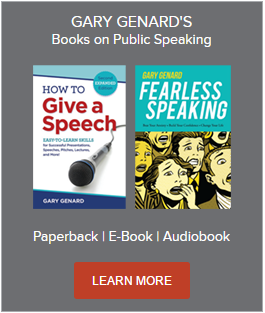
There's a secret you should know about how to create more concise and powerful speeches. Here's how to become a presentation artist!
Do you have it in you to become a great sculptor or poet?
How about putting together a tight, well-organized speech or presentation?
Of course you can do that! And in order to build such a presentation, you need to employ the same skill used to create a beautiful sculpture or a lasting poem: the subtle art of taking away.
Got a speech or presentation coming up where you need to activate listeners? Want your message to resonate with the audience so you move them to action? Learn the essential elements that will boost your success when you take center stage! Download my free guide, "7 Key Components of Successful Presentations."
How to Organize a Speech or Presentation
What I'm talking about here is the need to carefully select what you give to audiences. Think of that sculptor or poet. In each of those art forms, what the artist removes in the work of art is as vital as what he or she keeps in. The sculptor sees the finished product within, say, the block of marble, but it's only after endless hours of chipping away that we can participate in that vision. The poet, too, uses an extreme form of reduction, banishing all unnecessary words until the pure gem of the finished poem is left.
So, how good are you at reducing the vast amount of information you could present to your audience—which is always far more data than can or should be given? As readers of this blog know, I suggest that when it comes to deciding what to include in a presentation, you follow these three steps:
(1) Learn how to conduct an audience analysis so you understand your listeners' needs, expectations, and preferences.
(2) Decide on your specific purpose.
(3) Build your talk using only the material that will help you accomplish that purpose.
In effect, you'll be like our poet or sculptor, having removed all the extraneous information that will actually impede your ability to inform, persuade, or motivate. You'll end up with a tighter presentation that has more impact. And your audience will appreciate the difference.

The Key to Effective Public Speaking Is Conciseness
One interesting aspect of the ability to speak with this level of conciseness and control, is that it has nothing to do with the length of your speech. I recently saw this demonstrated in a setting that surprised me.
It was a break-out session at a conference showcasing new products. A series of speakers delivered a four-minute talk with slides on their company's product—how it met an urgent need, was innovative, exciting, etc. What surprised me was what a long time four minutes can be for an audience when a speech isn't tightly conceived and delivered.
We're all victims of overloaded PowerPoint slides that are cluttered, impossible to grasp in the time they're displayed, and when a long line of them is inflicted on us one after the other, coma-inducing. This practice in itself is a perfect example of the need to know the "secret" of what to leave out! Here's how to design and deliver an amazing presentation using PowerPoint.
How different those product pitches would have been if the speakers had practiced some public speaking discipline. They needed to ask the same question we should pose to ourselves: "What can I effectively display and discuss in the time I have for this talk?" Whether the time slot is four minutes or forty minutes is irrelevant. When we learn the art of careful pruning, we can truly become presentation artists.
You should follow me on Twitter here.




